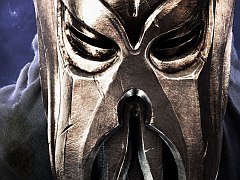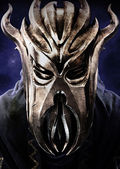You can trust VideoGamer. Our team of gaming experts spend hours testing and reviewing the latest games, to ensure you're reading the most comprehensive guide possible. Rest assured, all imagery and advice is unique and original. Check out how we test and review games here
Legend says that once you go black, you never go back, but it’s quite the opposite in Skyrim. Exploring has an addictive rhythm as you trudge around the world discovering new and exciting places, routinely ticking them off the list of stuff to do and see, and then revelling in the satisfying transformation of a compass icon turning from black to white. But every discovery of a new location brings you ever closer to the end of the adventure. You essentially ruin all the mysteries until there’s nothing left to discover and gawp at. This is prevalent in all games, where your best memories are always of the first hours in a new world, but it is especially true in Skyrim. In Skyrim, once that compass goes white, you can sadly never go back.
The compelling drive to explore and find new stuff is what the rather by-the-numbers Dawnguard forgot about, basing itself almost exclusively within Skyrim, around places you’d gazed at once a hundred hours ago, and nonchalantly passed by a thousand times since. Thankfully, the air punch-worthy conquest of changing some small icons from black to white is exactly what Dragonborn remembers most.
Set on the sizeable island of Solstheim, Dragonborn makes great use of its fresh territory. It’s separated into two distinct halves: one half reflecting the island’s close proximity to snowy Skyrim in the South West, and the other giving an HD representation of the eerie Dunmer homeland of Vvardenfell in the South East. At sea level, the dusty red plains and towering mushroom houses are instantly reminiscent of The Elder Scrolls III.
The rest of Solstheim’s snowy dunes and icy peaks feel much more like home, but it’s made fresh with neat little touches that make switching those little compass icons from black to white all the more thrilling. There’s an abundance of new stuff in Solstheim, and Dragonborn shows off some of the most intricately creative content I’ve seen so far in Skyrim. There are recognisable influences from the zany mania of Oblivion’s Shivering Isles, particularly in several visits to Hermaeus Mora’s otherworldly library, where huge tentacles slither around in black globules under your feet, and Seekers – a nasty new enemy type – haunt every corridor as the gargantuan library shifts around you like a literary labyrinth. It’s a world away from the dull, uninteresting expanse of Dawnguard’s Soul Cairn, to say the least.
With the uncharted territory comes a new main storyline and dozens of side quests, a handful of new materials to craft into fresh looking weapons and armour, and a couple of new spells and shouts – one of which, of course, lets you ride dragons through the skies. There are also new types of ingredients to harvest and a Dwemer fortress worth of great new enemy types to bump into and yell, “Oh wow, you are bloody ugly”, before slashing them to death with the Nordic Greatsword. If you had preconceived concerns about Dragonborn after Dawnguard fizzled out after about 8 hours, you’ve got nothing to worry about here. This is a DLC that can keep you busy for 20-25 hours without breaking a sweat, and upwards of 30 hours if you’re an investigative completionist.
Sadly, but altogether unsurprising considering The Elder Scrolls’ history, Dragonborn’s main story is pretty limp. Skyrim has never rested on the strengths of its narrative yarn, relying instead on the depth and strengths of its world, and in some cases the brilliance of the lesser-known quests, but the main plot feels like a wasted opportunity here. Fresh off the boat at Solstheim’s port town, Raven Rock, there are initial glimmers of something hopeful. The island is clad in a fog of mystery, and the constant question of ‘Who is Miraak?’ – your Dragonborn brethren – begins to stir some exciting suspicion. After all, the idea of two Dragonborn is an intriguing setup. But in execution the plot does very little to explore the idea of two colossal forces facing off against one another. Miraak is clearly nuts, but he only gets some minor screen time, and when he does appear he does nothing to grasp your interest any more than the last NPC. A climactic final encounter is truly excellent, but it makes way for an anti-climactic epilogue that barely lets you know the main quest has finished.
Thankfully, the places you visit in order to pursue Miraak are absolutely fantastic: the aforementioned tentacle library, sprawling Dwemer ruins, and a temple on the side of mountain – it’s all very impressive, and manages to detract the disappointing nature of the plot. Again, see the subtle magic of undiscovered compass icons at work. New enemy types, like the Nazgul-esque Serpentine Dragons and terrifying tentacle-lobbing Lurkers offer up new challenges for even the highest level characters, and a battle with the former quite early on in the main quest had me struggling for victory, despite the fact I’m a battle hardened level 65 Mage.
Of course, thanks to a new shout, you’re not solely confined to just slaying dragons any more. However, the dragon flying exposes Dragonborn’s other flaw. You can’t manually control your mount. Instead, you’re left to sit atop the beast while it circles around in a random holding pattern. You can lock onto enemies to attack them with ranged attacks, but doing so requires impressive precision, as you have no manual control over the beast you’re sitting atop. Like Dawnguard’s poorly thought out Vampire Lord form, flying dragons is something you’ll do a couple of times to see the majesty of Skyrim from the skies, and then forget about entirely.
That said, the magic of exploratory freedom is rife here, and not even the weaknesses of the main plot manage to excessively taint what is top-quality DLC. Sidelining the familiar sights of Dawnguard, Solstheim succeeds in providing a fantastic new playground. After completing the main quest in 11-12 hours, I still have a lot of side quests to complete, a majority of the map lies undiscovered and I haven’t even begun gathering all the new loot. Even better, this isn’t just more of the same Skyrim, as it offers a fresh glimpse of the corners of Tamriel that haven’t been seen in almost a decade. 1600 MSP isn’t cheap, but most of what Dragonborn offers is a new and exciting proposition that any seasoned Skyrimmer will heartily enjoy.
Version tested: Xbox 360
Skyrim: Dragonborn was played for approximately 12 hours covering the main quest, with additional hours put into side quests.
The Elder Scrolls V: Skyrim – Dragonborn
- Platform(s): PC, PlayStation 3, Xbox 360
- Genre(s): First Person, RPG







